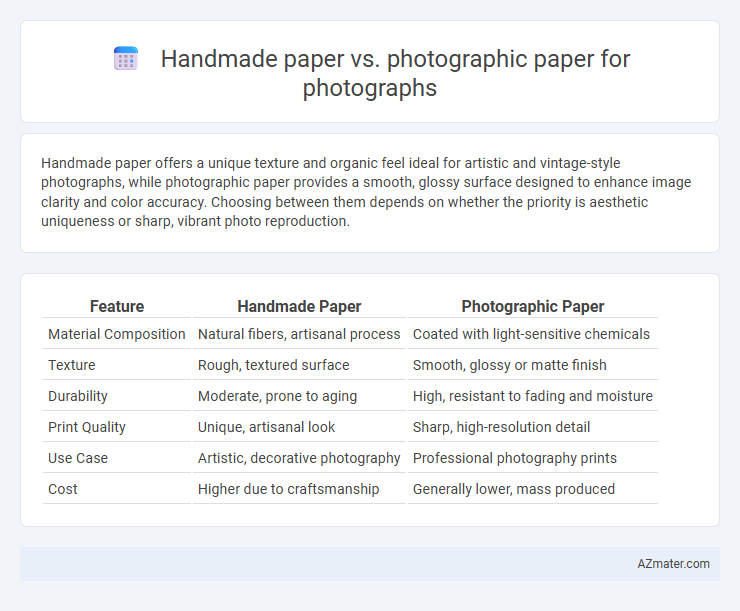Handmade paper offers a unique texture and organic feel ideal for artistic and vintage-style photographs, while photographic paper provides a smooth, glossy surface designed to enhance image clarity and color accuracy. Choosing between them depends on whether the priority is aesthetic uniqueness or sharp, vibrant photo reproduction.
Table of Comparison
| Feature | Handmade Paper | Photographic Paper |
|---|---|---|
| Material Composition | Natural fibers, artisanal process | Coated with light-sensitive chemicals |
| Texture | Rough, textured surface | Smooth, glossy or matte finish |
| Durability | Moderate, prone to aging | High, resistant to fading and moisture |
| Print Quality | Unique, artisanal look | Sharp, high-resolution detail |
| Use Case | Artistic, decorative photography | Professional photography prints |
| Cost | Higher due to craftsmanship | Generally lower, mass produced |
Introduction: Understanding Handmade and Photographic Papers
Handmade paper is crafted using traditional techniques that result in a textured, fibrous surface ideal for artistic photography prints seeking a unique, tactile quality. Photographic paper, engineered with a smooth, light-sensitive coating, ensures high-resolution image clarity and vibrant color reproduction, making it the preferred choice for professional photo printing. Understanding the distinct material properties and visual effects of each paper type helps photographers select the optimal substrate to enhance their artwork's aesthetic and longevity.
Key Differences Between Handmade and Photographic Paper
Handmade paper features a textured, fibrous surface ideal for artistic, vintage-style photographs, offering unique tactile qualities and environmental sustainability. Photographic paper provides a smooth, glossy or matte finish engineered for high-resolution image clarity, vibrant colors, and durability in prints. The key differences lie in texture, image sharpness, and intended use, with handmade paper emphasizing aesthetic appeal and photographic paper focusing on precision and color accuracy.
Texture and Surface Quality Comparison
Handmade paper offers a unique texture with natural fibers and irregular surface patterns that enhance the tactile quality and artistic depth of photographs. Photographic paper features a smooth, glossy or matte finish engineered for sharp image clarity and vibrant color reproduction. The textured surface of handmade paper adds warmth and character, while photographic paper prioritizes precise detail and consistent surface uniformity.
Color Reproduction: Handmade vs Photographic Paper
Handmade paper offers unique textures that can subtly influence color reproduction, often resulting in softer, more muted tones that emphasize artistic expression in photographs. Photographic paper, engineered specifically for photo printing, provides precise color accuracy and vibrant saturation due to its smooth, coated surface optimized for ink absorption. For photographers prioritizing true-to-life color fidelity and sharp detail, photographic paper remains superior, while handmade paper appeals to those seeking a distinct, tactile aesthetic with nuanced color variation.
Archival Qualities and Longevity
Handmade paper, often composed of natural fibers like cotton or hemp, offers superior archival qualities due to its acid-free and lignin-free composition, ensuring minimal degradation and enhanced longevity for photographic prints. Photographic paper, typically resin-coated or fiber-based with chemical coatings, provides high-resolution image quality but varies significantly in durability, with fiber-based papers generally offering better archival stability than resin-coated alternatives. Choosing handmade paper emphasizes preservation and aesthetic texture, while photographic paper balances image sharpness and longevity depending on its chemical treatment and storage conditions.
Print Detail and Image Sharpness
Handmade paper offers a unique texture that can enhance the artistic feel of a photograph but may reduce print detail and image sharpness due to its uneven surface. Photographic paper, designed specifically for photo printing, provides smooth, high-quality coatings that preserve fine details and deliver crisp, sharp images. For professional prints requiring maximum clarity and sharpness, photographic paper remains the optimal choice.
Environmental Impact and Sustainability
Handmade paper is crafted from natural fibers, often recycled or sustainably sourced, making it biodegradable and less harmful to the environment than photographic paper, which typically contains plastic coatings and chemical treatments that challenge recycling efforts. Photographic paper production involves the use of heavy metals and toxic chemicals such as silver halides, contributing to pollution and greater ecological footprints. Choosing handmade paper supports sustainable practices by reducing chemical waste and promoting biodegradability, aligning with eco-friendly photography initiatives.
Cost Considerations for Photographers
Handmade paper typically incurs higher costs due to its artisanal production process and limited supply, making it a premium choice for photographers seeking unique textures and originality. Photographic paper, mass-produced with specialized coatings for high image clarity and durability, offers cost efficiency and consistency suitable for large-scale or commercial photography projects. Photographers must balance budget constraints with artistic goals when selecting between handmade paper's bespoke quality and photographic paper's economical practicality.
Best Use Cases: Artistic vs Commercial Photography
Handmade paper excels in artistic photography due to its unique texture and organic feel, enhancing fine art prints and limited-edition collections. Photographic paper offers high-resolution clarity and consistent color reproduction, making it ideal for commercial photography requiring precise detail and vibrant images. Artists favor handmade paper for creative expression, while commercial photographers rely on photographic paper for professional-grade durability and sharpness.
Choosing the Right Paper for Your Photographic Style
Handmade paper offers a textured, organic feel that enhances fine art and vintage-style photographs by adding depth and uniqueness, making it ideal for photographers seeking a tactile, artistic presentation. Photographic paper, designed with a smooth, glossy or matte finish, provides vibrant color reproduction and sharp detail, perfect for contemporary, high-resolution images requiring professional quality and longevity. Selecting the right paper hinges on your photographic style: choose handmade paper for expressive, textured works, and photographic paper for crisp, detailed prints with accurate color fidelity.

Infographic: Handmade paper vs Photographic paper for Photograph
 azmater.com
azmater.com